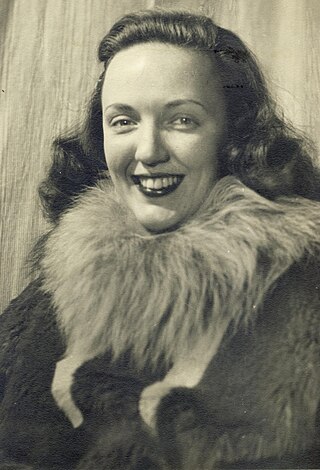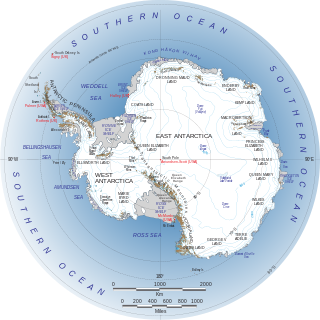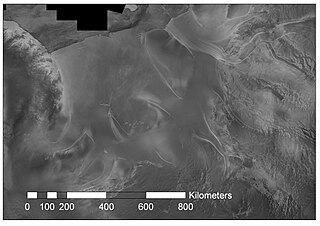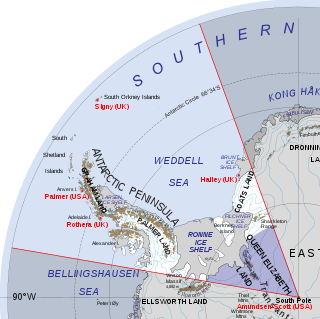
The British Antarctic Territory (BAT) is a sector of Antarctica claimed by the United Kingdom as one of its 14 British Overseas Territories, of which it is by far the largest by area. It comprises the region south of 60°S latitude and between longitudes 20°W and 80°W, forming a wedge shape that extends to the South Pole, overlapped by the Antarctic claims of Argentina and Chile.

Finn Ronne was a Norwegian-born U.S. citizen and Antarctic explorer.

Jackie Ronne was an American explorer of Antarctica and the first woman in the world to be a working member of an Antarctic expedition (1947–48). She is also the namesake of the Ronne Ice Shelf.

Berkner Island is an Antarctic ice rise, where bedrock below sea level has caused the surrounding ice sheet to create a dome. If the ice cap were removed, the island would be underwater. Berkner Island is completely ice-covered and is about 320 kilometres (200 mi) long and 150 kilometres (93 mi) wide, with an area of 44,000 km2 (17,000 sq mi). It is surrounded by the Filchner-Ronne Ice Shelf. The northernmost point of the Berkner is about 20 kilometres (12 mi) from the open sea. It lies in the overlapping portion of the Argentine and the British Antarctic territorial claims.

Palmer Land is the portion of the Antarctic Peninsula, Antarctica that lies south of a line joining Cape Jeremy and Cape Agassiz. This application of Palmer Land is consistent with the 1964 agreement between the Advisory Committee on Antarctic Names and the UK Antarctic Place-Names Committee, in which the name Antarctic Peninsula was approved for the major peninsula of Antarctica, and the names Graham Land and Palmer Land for the northern and southern portions, respectively. The line dividing them is roughly 69° S.

Ellsworth Land is a portion of the Antarctic continent bounded on the west by Marie Byrd Land, on the north by Bellingshausen Sea, on the northeast by the base of Antarctic Peninsula, and on the east by the western margin of the Filchner–Ronne Ice Shelf. It extends between 103°24'W and 79°45'W. The area west of 90°W is unclaimed, the area between 84°W and 90°W is claimed by Chile only, and the remainder by Chile and the United Kingdom as a part of the British Antarctic Territory. Eights Coast stretches between 103°24'W and 89°35'W, and Bryan Coast between 89°35'W and 79°45'W.


Stonington Island is a rocky island lying 1.8 km (1.1 mi) northeast of Neny Island in the eastern part of Marguerite Bay off the west coast of Graham Land, Antarctica. It is 0.75 km (0.47 mi) long from north-west to south-east and 0.37 km (0.23 mi) wide, yielding an area of 20 ha. It was formerly connected by a drifted snow slope to Northeast Glacier on the mainland. Highest elevation is Anemometer Hill which rises to 25 m (82 ft).

The Amery Ice Shelf is a broad ice shelf in Antarctica at the head of Prydz Bay between the Lars Christensen Coast and Ingrid Christensen Coast. It is part of Mac. Robertson Land. The name "Cape Amery" was applied to a coastal angle mapped on 11 February 1931 by the British Australian New Zealand Antarctic Research Expedition (BANZARE) under Douglas Mawson. He named it for William Bankes Amery, a civil servant who represented the United Kingdom government in Australia (1925–28). The Advisory Committee on Antarctic Names interpreted this feature to be a portion of an ice shelf and, in 1947, applied the name Amery to the whole shelf.

Luitpold Coast is that portion of the coast of Coats Land extending from the vicinity of Hayes Glacier, at 27°54′W, to 36°W, which is regarded as the eastern limit of the Filchner Ice Shelf. It was discovered by Wilhelm Filchner, leader of the Second German Antarctic Expedition, 1911–12, and named after Luitpold, Prince Regent of Bavaria.

Cole Peninsula is a peninsula, 24 kilometers long in an east–west direction and 13 kilometers wide, lying between Cabinet Inlet and Mill Inlet on the east coast of Graham Land, just east of Thuronyi Bluff and immediately north of the Antarctic Circle. The peninsula is surrounded by the Larsen Ice Shelf, which is part of the Weddell Sea.
Ronne Entrance is a broad southwest entrance of the George VI Sound where it opens from the southeast portion of the Bellingshausen Sea at the southwest side of Alexander Island, Antarctica. The south side of the Monteverdi Peninsula occupies the north portion of the Ronne Entrance while Ellsworth Land occupies the southern portion of the entrance. The entrance receives much ice throughout the whole year mainly because the entrance protrudes eastward into the adjacent George VI Sound and the George VI Ice Shelf from the southwest section, the Ronne Entrance is also prone to ice flow from the Bach Ice Shelf as well as receiving ice from the Wilkins Ice Shelf. There are a few islands situated within the Ronne Entrance, mainly in the southwest area. Some of these islands include the Eklund Islands, DeAtley Island, Spaatz Island, Case Island and Smyley Island. It was discovered on a sledge journey through the sound in December 1940 by U.S. Polar explorer Finn Ronne and Carl Eklund of the US Antarctic Service (USAS), 1939–41, and named "Ronne Bay". Finn Ronne covered more miles by ski and sled dog than any other explorer in history and mapped the last unknown coastline on earth on his Ronne Antarctic Research Expedition in 1947.
Ronne or Rønne can refer to the following:

Möller Ice Stream is an Antarctic ice stream that drains an area of 66,000 square kilometres (25,000 sq mi) of the West Antarctic Ice Sheet as it flows north-northeast into the Ronne Ice Shelf to the west of Foundation Ice Stream. The drainage basin of this ice stream is separated by the Rambo Nunataks from the drainage basin of Foundation Ice Stream.
Monteverdi Peninsula is a large ice-covered peninsula lying between the Bach Ice Shelf and George VI Sound, forming the southernmost extremity of Alexander Island, Antarctica. The southern side of the feature was first seen and charted by Finn Ronne and Carl Eklund of the United States Antarctic Service, 1939–41, who traversed the entire length of George VI Sound. The peninsula was mapped from trimetrogon air photography taken by the Ronne Antarctic Research Expedition in 1947–48, and from survey by the Falkland Islands Dependencies Survey, 1948–50. It was named by the UK Antarctic Place-Names Committee after Italian composer Claudio Monteverdi.

Gould Bay is a bay located at the junction of the Filchner Ice Shelf with the northeast corner of Berkner Island, in the southern Weddell Sea. It was discovered by the Ronne Antarctic Research Expedition, 1947–48, under the leadership of Commander Finn Ronne, U.S. Navy Reserve, who named this bay for Laurence M. Gould, geologist, geographer, and second in command of the Byrd Antarctic Expedition, 1928–30.

The Lassiter Coast is the portion of the east coast of the Antarctic Peninsula that extends from Cape Mackintosh to Cape Adams. The northern portion of this coast was discovered and photographed from the air by the United States Antarctic Service in 1940. During 1947 the entire extent of the coast was photographed from the air by the Ronne Antarctic Research Expedition (RARE) under Finn Ronne, who in conjunction with the Falkland Islands Dependencies Survey charted it from the ground.

Queen Elizabeth Land is a portion of mainland Antarctica named by the government of the United Kingdom and claimed as part of the British Antarctic Territory. Situated south of Weddell Sea and between longitudes 20°W and 80°W, stretching from Filchner-Ronne Ice Shelf to the South Pole. It is bordered by Zumberge Coast of Ellsworth Land to the West and by Hercules Inlet to the Northwest. To the Northeast, circle of latitude 82°S is the dividing line against Coats Land. The area of Queen Elizabeth Land was unnamed until 2012, though most of it was unofficially known as Edith Ronne Land in 1947–68 and includes areas claimed by the United Kingdom, Chile and Argentina.
Hall Glacier is a glacier flowing north between Lidke Ice Stream and Nikitin Glacier into Stange Sound on the English Coast of Palmer Land. Named by the Advisory Committee on Antarctic Names in 2006 after Dann V. Hall, a U.S. Geological Survey (USGS) surveyor in support of the Ross Ice Shelf Project, 1976–77; team member, joint USGS-British Antarctic Survey Doppler Landsat Control Project, 1977–78, via Twin Otter aircraft and ship to discrete positions at Haag Nunataks, Orville Coast, the Antarctic Peninsula, Ronne Ice Shelf, Filchner Ice Shelf, Lyddan Island, Theron Mountains, Deception Island, Signy Island, Bird Island and South Georgia.
















